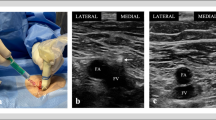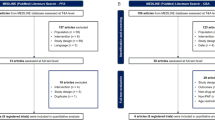Abstract
Purpose
Left atrial thrombus (LAT) may be detected by transesophageal echocardiography (TEE) in patients with atrial fibrillation (AF) or flutter (AFL) despite continuous anticoagulation therapy. We sought to examine the rates and timing of LAT resolution in response to changes in anticoagulation regimen.
Methods
A retrospective study of 1517 consecutive patients on ≥ 4 weeks continuous oral anticoagulation (OAC) undergoing TEE prior to either direct current cardioversion or catheter ablation for AF or AFL was performed. Patients who had LAT on index TEE imaging and had follow-up TEEs were analyzed.
Results
Despite ≥ 4 weeks of continuous anticoagulation therapy, 63 (4.2%) patients had LAT. Forty-four patients (median age 67 [IQR 58, 74]; 33 [75%] male; 25 [57%] on direct oral anticoagulant [DOAC]) had follow-up TEEs performed. Upon detection of LAT on index TEE, 8 patients switched from warfarin to a DOAC, 21 patients switched from a DOAC to warfarin or another DOAC, and 15 patients remained on the same OAC. Over median 4.2 months (IQR 2.9, 6.6), LAT resolution was seen in 25 (57%) patients. Of the 25 patients who had LAT resolution, 7 (28%) required TEE imaging > 6 months after index TEE to show clearance of thrombus. Rates of LAT resolution were similar between patients who had alterations in OAC and those who did not (52 vs. 60%; P = 0.601).
Conclusions
After initial detection of left atrial thrombus despite uninterrupted anticoagulation for atrial fibrillation or flutter, > 40% patients have persistent clot despite additional extended anticoagulation.



Similar content being viewed by others
References
Al-Saady NM, Obel OA, Camm AJ. Left atrial appendage: structure, function, and role in thromboembolism. Heart. 1999;82:547–54.
Manning WJ, Silverman DI, Gordon SP, Krumholz HM, Douglas PS. Cardioversion from atrial fibrillation without prolonged anticoagulation with use of transesophageal echocardiography to exclude the presence of atrial thrombi. N Engl J Med. 1993;328:750–5.
Seidl K, Rameken M, Drogemuller A, Vater M, Brandt A, Schwacke H, et al. Embolic events in patients with atrial fibrillation and effective anticoagulation: value of transesophageal echocardiography to guide direct-current cardioversion. Final results of the Ludwigshafen observational cardioversion study. J Am Coll Cardiol. 2002;39:1436–42.
Frenkel D, Al-Kazaz M, Markowitz SM, Liu CF, Thomas G, Ip JE, et al. Prevalence of left atrial thrombus by transesophageal echocardiography: a comparison of continuous non-vitamin k antagonist oral anticoagulant versus warfarin therapy in patients undergoing catheter ablation for atrial fibrillation. JACC Clin Electrophysiol. 2016;2:295–303.
Wu M, Gabriels J, Khan M, Shaban N, D'Amato S, Liu CF, et al. Left atrial thrombus and dense spontaneous echocardiographic contrast in patients on continuous direct oral anticoagulant therapy undergoing catheter ablation of atrial fibrillation: comparison of dabigatran, rivaroxaban, and apixaban. Heart Rhythm. 2018 April;15(4):496–502.
Lip GY, Hammerstingl C, Marin F, Cappato R, Meng IL, Kirsch B, et al. Rationale and design of a study exploring the efficacy of once-daily oral rivaroxaban (X-TRA) on the outcome of left atrial/left atrial appendage thrombus in nonvalvular atrial fibrillation or atrial flutter and a retrospective observational registry providing baseline data (CLOT-AF). Am Heart J. 2015;169:464–71. e462
Lip GY, Hammerstingl C, Marin F, Cappato R, Meng IL, Kirsch B, et al. Left atrial thrombus resolution in atrial fibrillation or flutter: results of a prospective study with rivaroxaban (X-TRA) and a retrospective observational registry providing baseline data (CLOT-AF). Am Heart J. 2016;178:126–34.
Lip GY, Nieuwlaat R, Pisters R, Lane DA, Crijns HJ. Refining clinical risk stratification for predicting stroke and thromboembolism in atrial fibrillation using a novel risk factor-based approach: the Euro heart survey on atrial fibrillation. Chest. 2010;137:263–72.
Jaber WA, Prior DL, Thamilarasan M, Grimm RA, Thomas JD, Klein AL, et al. Efficacy of anticoagulation in resolving left atrial and left atrial appendage thrombi: a transesophageal echocardiographic study. Am Heart J. 2000;140:150–6.
Vidal A, Vanerio G. Dabigatran and left atrial appendage thrombus. J Thromb Thrombolysis. 2012;34:545–7.
Takasugi J, Yamagami H, Okata T, Toyoda K, Nagatsuka K. Dissolution of the left atrial appendage thrombus with rivaroxaban therapy. Cerebrovasc Dis. 2013;36:322–3.
Hammerstingl C, Potzsch B, Nickenig G. Resolution of giant left atrial appendage thrombus with rivaroxaban. Thromb Haemost. 2013;109:583–4.
Dobashi S, Fujino T, Ikeda T. Use of apixaban for an elderly patient with left atrial thrombus. BMJ Case Rep. 2014;2014:bcr2014203870.
Kirchhof P, Benussi S, Kotecha D, Ahlsson A, Atar D, Casadei B, et al. 2016 ESC guidelines for the management of atrial fibrillation developed in collaboration with EACTS. Europace. 2016;18:1609–78.
January CT, Wann LS, Alpert JS, Calkins H, Cigarroa JE, Cleveland JC Jr, et al. 2014 AHA/ACC/HRS guideline for the management of patients with atrial fibrillation: a report of the American College of Cardiology/American Heart Association task force on practice guidelines and the Heart Rhythm Society. J Am Coll Cardiol. 2014;64:e1–76.
Bernhardt P, Schmidt H, Hammerstingl C, Hackenbroch M, Sommer T, Luderitz B, et al. Fate of left atrial thrombi in patients with atrial fibrillation determined by transesophageal echocardiography and cerebral magnetic resonance imaging. Am J Cardiol. 2004;94:801–4.
Lip GY, Lane DA. Matching the NOAC to the patient: remember the modifiable bleeding risk factors. J Am Coll Cardiol. 2015;66:2282–4.
Berger M, Schweitzer P. Timing of thromboembolic events after electrical cardioversion of atrial fibrillation or flutter: a retrospective analysis. Am J Cardiol. 1998;82:1545–7.
Nagarakanti R, Ezekowitz MD, Oldgren J, Yang S, Chernick M, Aikens TH, et al. Dabigatran versus warfarin in patients with atrial fibrillation: an analysis of patients undergoing cardioversion. Circulation. 2011;123:131–6.
Author information
Authors and Affiliations
Corresponding author
Ethics declarations
Conflict of interest
The authors declare that they have no conflict of interest.
Rights and permissions
About this article
Cite this article
Wu, M.S., Gabriels, J., Khan, M. et al. Left atrial thrombus despite continuous direct oral anticoagulant or warfarin therapy in patients with atrial fibrillation: insights into rates and timing of thrombus resolution. J Interv Card Electrophysiol 53, 159–167 (2018). https://doi.org/10.1007/s10840-018-0432-1
Received:
Accepted:
Published:
Issue Date:
DOI: https://doi.org/10.1007/s10840-018-0432-1




